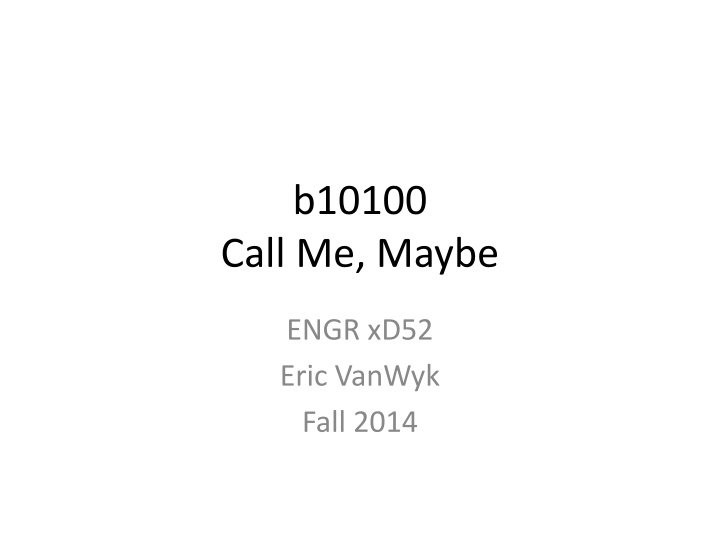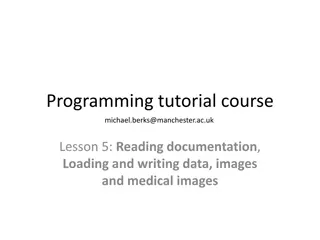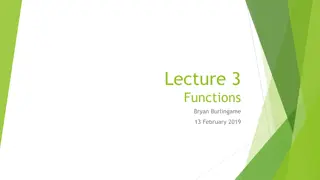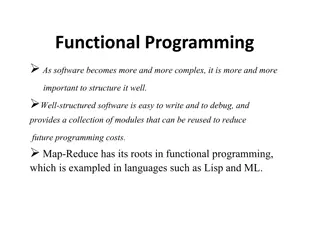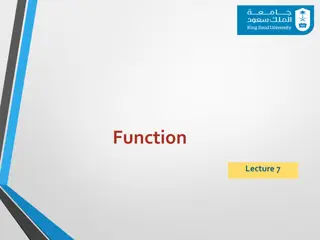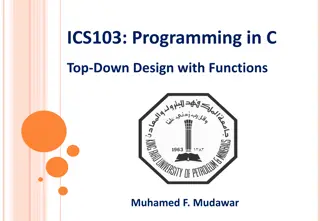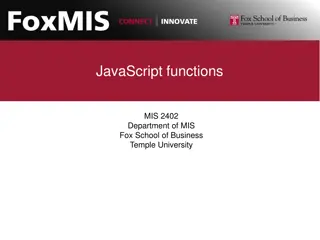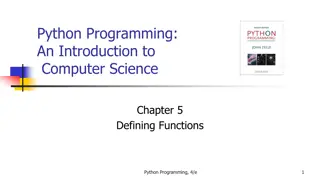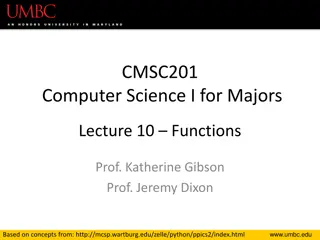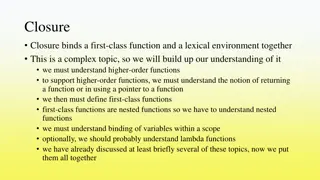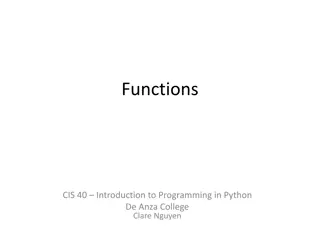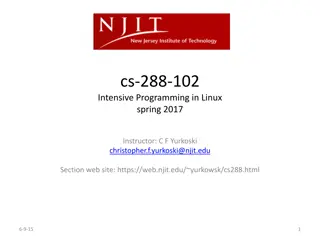Functions in Programming
A comprehensive exploration of functions in programming, covering concepts like what a function is, its role in code execution flow, calling conventions, and control passing between caller and callee. Learn about the structure and purpose of functions in a clear and engaging manner.
Download Presentation

Please find below an Image/Link to download the presentation.
The content on the website is provided AS IS for your information and personal use only. It may not be sold, licensed, or shared on other websites without obtaining consent from the author.If you encounter any issues during the download, it is possible that the publisher has removed the file from their server.
You are allowed to download the files provided on this website for personal or commercial use, subject to the condition that they are used lawfully. All files are the property of their respective owners.
The content on the website is provided AS IS for your information and personal use only. It may not be sold, licensed, or shared on other websites without obtaining consent from the author.
E N D
Presentation Transcript
b10100 Call Me, Maybe ENGR xD52 Eric VanWyk Fall 2014
Today Calling Simple/ Leaf Functions The Stack Calling Generic Functions Calling Conventions mp3
What is a function? A procedure is a stored subroutine that performs a specific task based on the parameters it is provided. <Pattersen & Hennessy> a = f(x,y,z); // You have seen this before A spy on a secret mission Seriously, the textbook we used to use is hilarious.
What is a function? A block of code formatted in a way that allows it to be called by other code, and then returns execution to the caller How is this similar to / different from one of our GOTO targets?
The Life of a Called Function The caller stores parameters somewhere Control (Execution) is passed to the callee The callee does some stuff The callee stores the results somewhere Control is passed back to the caller
Calling Conventions A Calling Convention standardizes where those somewheres are. Registers? Data Memory? Return values? How do we return control back to the caller? It is just another type of contract The great thing about standards is that there are so many to choose from.
Execution Flow Lets work through a simple example void main() { // do some stuff MyFunction(); // do other stuff }
Execution Flow Idea 1: #Caller (main) #do stuff j MyFunction returnToMain: #dootherstuff Jump to subroutine Jump back when done #callee MyFunction: #code code code j returnToMain
Execution Flow Idea 1: #Caller (main) #do stuff j MyFunction returnToMain: #dootherstuff Jump to subroutine Jump back when done #callee MyFunction: #code code code j returnToMain What if I want to use the function again elsewhere?
Execution Flow Idea 2: #Caller (main) #do stuff ReturnAddr = PC+??? j MyFunction returnToMain: #dootherstuff Store return address Jump to subroutine Jump back when done #callee MyFunction: #code code code jr ReturnAddr
Execution Flow In MIPS, this is called Jump And Link (jal) #Caller (main) #do stuff jal MyFunction #dootherstuff jal stores the PC+4 to $31 and then jumps to the target address #callee MyFunction: #code code code jr $ra $31 is also known as $ra Return Address Jump Register (jr) to get back
Execution Flow Storing the Return Address in $ra is great! but only for Leaf Functions What if a function calls another function? Put it in Data Memory! Every function has a dedicated space to shove $ra
Execution Flow Storing the Return Address in $ra is great! but only for Leaf Functions What if a function calls another function? Put it in Data Memory! Every function has a dedicated space to shove $ra What if A FUNCTION CALLS ITSELF?!?! OMG Inception
Stack Attack Dedicating memory per function is limiting Wastes space when it isn t active Can t recurse Instead, allocate data memory as needed We use The Call Stack Last In, First Out Push stuff onto the head of the stack Pop stuff back off of it
The Call Stack Is a Stack of Frames Each active function instantiation has a Frame Frames hold the instance memory Like the return address
Mechanics of the Call Stack Architecture Decisions: Where is the Stack? How do we address it / point to it? Linked List? Raw Pointer? Calling Convention Decisions: What stuff is put on it? In what order? (Frame Definition) By whom? (Caller? Callee?)
Mechanics of the Stack Ascending/Descending Ascending stacks start at address 0 and grow up Descending stacks start at the other end and grow down Full / Empty Empty stack pointers point to the next unallocated address Full stack pointers point to the top item in the stack MIPs uses a full descending stack With $29 ($sp) as the stack pointer ARM supports all 4, usually uses full descending Procedure Call Standard for the ARM Architecture (AAPCS)
Why Descending? There are two dynamic memory spaces The Heap handles memory dynamically allocated at run time malloc /free new / delete Traditionally: Heap ascends Stack descends Giovanni Gracioli
Full Descension Example PUSH $t3, $t4 onto the stack addi $sp, $sp, -8 sw $t3, 4($sp) sw $t4, 0($sp) #allocate 2 word #push $t3 #push $t4 What does the stack look like after this push? Does order of operations matter here?
Full Descension Example Pop $t3, $t4 from the stack lw $t3, 4($sp) lw $t4, 0($sp) addi $sp, $sp, 8 #pop $t3 #pop $t4 #delete 2 words What does the stack look like after this push? Two pops, one add
Factorial Function int Fact(int n){ if(n>1) return n* Fact(n-1) else return 1
Factorial Function int Fact(int n){ if(n<=1) goto end: return n* Fact(n-1) end: return 1
Factorial Function $v0 Fact(int n){ if(n<=1) goto end: $v0 =n* Fact(n-1) jr $ra end: $v0 = 1 jr $ra
Factorial Function We have most of what we need: Goto flow control for if jr $ra for return Registers assigned Now we need to call Fact What do we save? What order? Lets focus on the call site $v0 Fact ($a0) ble $a0, 1, end: $v0 =n* Fact(n-1) jr $ra end: $v0 = 1 jr $ra
Factorial Function Call Site To Call Fact: Push registers I need to save $ra $a0 Setup Arguments N-1: $a0 = $a0-1 Jump and Link Fact: Restore registers
Factorial Function Call Site add $sp, $sp, -8 sw $ra, 4($sp) sw $a0, 0($sp) add $a0, $a0, -1 jal fact lw $ra, 4($sp) lw $a0, 0($sp) add $sp, $sp, 8 To Call Fact: Push $ra, $a0 Setup $a0 Jump and Link Fact: Restore $ra, $a0
Factorial Function Call Site add $sp, $sp, -8 sw $ra, 4($sp) sw $a0, 0($sp) add $a0, $a0, -1 jal fact lw $ra, 4($sp) lw $a0, 0($sp) add $sp, $sp, 8 To Call Fact: Push $ra, $a0 Setup $a0 Jump and Link Fact: Restore $ra, $a0
Factorial Function Call Site add $sp, $sp, -8 sw $ra, 4($sp) sw $a0, 0($sp) add $a0, $a0, -1 jal fact lw $ra, 4($sp) lw $a0, 0($sp) add $sp, $sp, 8 To Call Fact: Push $ra, $a0 Setup $a0 Jump and Link Fact: Restore $ra, $a0
Factorial Function Call Site add $sp, $sp, -8 sw $ra, 4($sp) sw $a0, 0($sp) add $a0, $a0, -1 jal fact lw $ra, 4($sp) lw $a0, 0($sp) add $sp, $sp, 8 To Call Fact: Push $ra, $a0 Setup $a0 Jump and Link Fact: Restore $ra, $a0
Factorial Function fact: ;if(N<=1) return 1 ble $a0, 1, end: ;Pop $ra, $a0 lw $ra, 4($sp) lw $a0, 0($sp) add $sp, $sp, 8 ;Push $ra, $a0 add $sp, $sp, -8 sw $ra, 4($sp) sw $a0, 0($sp) ;Return N*Fact(N-1) mul $v0, $v0, $a0 jr $ra ;Argument N-1 add $a0, $a0, -1 end: ;Return 1 $v0 = 1 jr $ra jal fact
Calling Function li $a0, 4 jal factorial move $s0, $v0 Calls Factorial several times Stores results in $sN li $a0, 2 jal factorial move $s1, $v0 li is a pseudoinstruction What does it assemble to?? The final two lines call a special simulator function to end execution 10 means exit Look up other syscalls in help li $a0, 7 jal factorial move $s2, $v0 li $v0, 10 syscall
Calling Convention We have decisions to make for registers: Are they used as part of the call? Are they preserved across the call? Are they reserved for other uses? and about passing arguments around In registers? On the stack? In generic data memory?
Where is the stack frame constructed? By the Caller Right before and after the jal Preserve own register state just in case By the Callee Push after functionname: , Pop before jr Preserve register state so they are usable Which reduces unnecessary push/pops?
MIPs Specifics Uses $vN to store results V for Valuetta Uses $aN to store first 4 arguments A is for Argument, that s good enough for me Extra are pushed to the stack
MIPs Specifics $sN are Saved Temporaries The callee is responsible for saving these if used The caller can assume they are unchanged $tN are Volatile Temporaries The callee can do whatever it wants with these The caller can t rely on these across a call Advantages/Disadvantages to these?
Lets Do This Write the Fibonacci function recursively: int Fibonacci(int x) { if (x == 0) return 0; // Stopping conditions if (x == 1) return 1; return Fibonacci(x - 1) + Fibonacci(x - 2); } You will have to invent parts of your own calling convention here. Take notes on what you invented. Where do you store parameters? Return Values? Return Addresses? This will be easier if you write in human first Drawing your stacks helps too!
Frame Pointer $sp can move around during a procedure This makes frame contents shift around Relative to the stack pointer Makes debugging hard A Frame Pointer stays put during a procedure Makes debugging easier! Makes compiling easier too, but I don t care
Frame Pointer Isn t strictly necessary But it makes debugging so much easier Not all implementations use it GNU MIPS C Compiler does MIPS MIPS C compiler does not
A MIPS calling conventions frame From WinCE 5.0 Arguments at top of previous frame $ra Saved nonvolatiles Locals http://msdn.microsoft.com/en-us/library/aa448710.aspx
Vocab Blowing the Stack / Stack Overflow / Stack Smashing Running out of stack space Writes over other data! (Heap) Possible security vulnerability Unwind the Stack Popping frames off the stack Usually in the context of exception handling Walking the Stack Looking at the Stack and figuring out where you are Usually in the context of Debugging Need to be able to see where the frames are
Vocab Misaligning or Unbalancing the stack Pushing or popping a different number of times Catastrophic Error! Stack Dump Produced when program crashes Helps you understand where you were when stuff went wrong
Stack Dump Example Error Message: Value cannot be null. Parameter name: value Exception: ArgumentNullException Suggestion: Contact National Instruments to report this error Stack Trace: at System.BitConverter.ToInt32(Byte[] value, Int32 startIndex) at NationalInstruments.LabVIEW.VI.VirtualMachine.Target.ExecutionHighlighting.ProcessUpdate(Byte[] buffer) at NationalInstruments.X3.Model.DeviceModel.OnExHighlightReadCompletedEventHandler(Object sender, ReadCompletedEventArgs e) at NationalInstruments.X3.Model.DeviceModel.<>c__DisplayClass37.<ReadTargetMemory>b__36(Object theSender, RequestCompletedEventArgs theE)
mp3 Final Lab! Schedule Stinks Try to avoid working over the break
Final Project Individually, send in 1 rough idea for a Final Project Due Wednesday at Noon comparch14@gmail.com [FP Idea]
